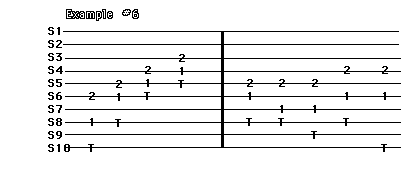 Basic Rolls
| Basic Rolls & Slides
| Left Hand Logic
| E9th Pickgrips |
Basic Rolls
| Basic Rolls & Slides
| Left Hand Logic
| E9th Pickgrips |
Right Hand Logic | The
Right Hand | The Forward
Roll |
 E9th
Pick Grips E9th
Pick Grips
Learning to play different grips with your picks can be
a very frustrating thing to master. When we learn beginner grips we
are usually seeing them as they apply to certain string groups that
we use to play major triads. I took a different approach and tried to
look at them in a more abstract way. What about the possibilities? I
figured out how many ways my three finger and one thumb pick could play
twelve strings. Some of them are wider than your fingers can reach,
but I still took a look at them.
To look at all the grips I started
with my picks on strings that were all adjacent and then started putting
strings in between and through the process of elimination, I came up
with all the possibilities.
Example #5 shows a few of the ones
I use the most. They are all shown with the thumb on the tenth string.
Remember to train your hand to play them across the strings. As your
hands build up dexterity you'll find playing chords on your steel becomes
easier.

You can practice
playing grips across the strings on any neck. The thing to do is not
worry about what the notes are. Concentrate on your right hand moving
across the strings. You should at least know the basic grips and be
able to play them across the strings. And one day you should be able
to interchange them from any position and any grip.
Another way I used to learn pick
grips is by giving a grip a code. If you use two finger picks you use
two numbers and with three finger picks I use three numbers. How does
this work? Its pretty simple. The numbers represent the number of strings
between each pick. For example grip #1 has all picks on adjacent strings.
This gives it a pickgrip number of (0.0). Pickgrip #2 has a number of
(1.0). The first number represents the number of strings between your
thumb and your first finger. The second number is the number of strings
between your first finger and second finger.
I use three finger picks and one
thumb picks and can play four note chords without strumming the guitar.
I use the pickgrip numbers to help me remember licks and to help me
find new ways to play. Once I trained my hand to move from grip to grip
without fumbling, that gave my playing an advantage. I can go back to
basic movements in the middle of a solo. Having that contrrol makes
you comfortable and relaxed. This allows you to create.
The grips can be assigned numbers
to help you understand them. The idea is to make the movements by the
right hand automatic. You should be able to pick any grip on any set
of strings. I see the grips starting with the thumb. The string the
thumb is on is its position. Example #5 shows all of the grips
in the tenth position. Remember, that you can move them across the strings.
The dexterity and coordination it
takes for you to play these grips will come to you after hours of practice.
There is no other way. Start slow and learn to move your picks from
position to position with precision. Learning slow will allow you to
put the music into your hands. As you work on the grips, remember that
at the end of the journey you'll be able to produce more and more music
on your steel.

Example
#6 shows us using different grips. These are just basic examples
to be associated with movement. Don't worry about what chord or which
pedal. Just concentrate on seeing the movement in your mind and transferring
that to your hand.
The wider grips are great for those
big chords you like to play. The hands can play more if they know more.
The best thing to do is to keep practicing. The more time you spend
behind your steel, the more you will see it in your playing. You've
got to put the music in your hands.

|

